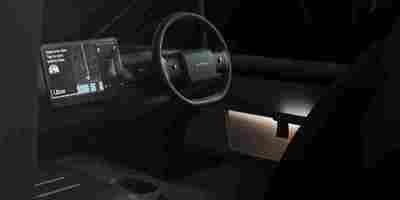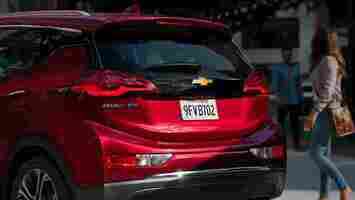Here’s why they don’t make stick shift EVs
When I first sat behind the wheel of an EV , I noticed something missing: the clutch and the gear stick.

The reason behind this is simple. EVs don’t have a gearbox. They’re automatic. So instead of a stick, you’ll find a lever, switch, or button that allows you to select “drive,” “park,” and “reverse.”


Unlike petrol or diesel cars, they don’t need them.
The internal combustion engine of conventional vehicles develops its power and torque at different RPMs (revolutions per minute), and therefore it needs a gearbox with various gear ratios to effectively transfer the power from the engine to the wheels.
This means that such vehicles deliver their optimum performance within a small, narrow revolution range — or “rev band,” as it’s commonly known.
Electric vehicles don’t have this limitation. These motors deliver power instantly, meaning the process of building up torque through revving — as in internal combustion engines — is unnecessary.
Plus, EV motors have a much larger RPM range than their ICE peers. They can hit up to 20,000rpm, compared to the 6,000rpm limit of most conventional cars.
Basically, EV engineers only need to design a one-ratio, single-speed transmission that effectively regulates the electric motor — and delivers the best balance between acceleration and top speed.
Single-speed is definitely the norm, but we do have two exceptions: the Porsche Taycan and the Audi e-tron GT .
They both feature a two-speed automatic gearbox to maximize acceleration and optimize efficiency at higher speeds.
Does this mean we’re possibly looking at a two-speed future for EVs in general? No, I wouldn’t say so.
From a manufacturing point of view, a single-gear system reduces cost and complexity. This helps automakers save up some extra money and, in turn, keep EVs affordable.
While there are some performance benefits to things like the Taycan (from $82,700) and e-tron GT ($140,000), they’re far too pricey for the average consumer.
And there you have it. Next time someone asks you where the stick shift EVs are, you’ll wow them with your knowledge.
Uber still pretends not to be a taxi firm, but is going to make a taxicab anyway
Ride-hailing mega-platform Uber, and Arrival, a British electric van and bus manufacturer, are teaming up to make an electric car specifically for gig-working drivers.

On the one hand it sounds great, on the other… it takes Uber even further down the path of becoming like an old-school taxi firm.
The deal
Announced earlier today, the pair are working together to develop the “Arrival car” an “affordable, purpose-built electric vehicle for ride-hailing,” Reuters reports .
The car will go into production at the end of next year.
It all comes as part of Uber’s plan to become a fully electric mobility platform in London by 2025, and North America and Europe by 2030.
The upside and challenge
Turning to an entirely electric fleet is an undeniably good thing. In cities, where most Uber rides occur, it will help reduce emissions and noise pollution.
It still doesn’t address the fact that ride-hailing companies like Uber and Lyft have been found to create congestion , but it’s a start.
An announcement from Arrival, says that the car will be designed in collaboration with drivers, to best meet their needs. The vehicle is also supposed to be “affordable,” but until we have an on-the-road price, it’s impossible to say how this will stack up.
No details on how Uber is going to support drivers in making the switch to electric power have been shared either.
The company has raised $188 million (£135 million) to help its drivers make the switch, but it’s not clear how this will be used when the Arrival Car, um, arrives.


At present, Uber gives drivers a number of kickbacks for driving an electric vehicle in the UK.
There are preferential finance deals with a number of electric carmakers such as Kia, Nissan, and Hyundai.
For drivers in London, an extra 3 pence per mile is added to fares, to boost earnings.
Until the end of 2021, drivers of EVs will pay a reduced service fee of 15%, typically this fee varies from journey to journey. However, some industry folk suggest Uber takes around 25% of the cost of the fare as a service fee.
Now, there’s one important thing to keep in mind. Uber uses these kinds of financial benefits as incentives, and they don’t last forever .
By the time Uber is fully electric in the UK, or perhaps even by the time the majority of its workers are in EVs, you can be sure these incentives will be pulled. The service fee will no doubt return to normal.
What about choice?
While Uber and Arrival are designing the car specifically for ride-hailing drivers, it’s not an exclusive deal.
This means that any ride-hailing worker could use this vehicle. Perhaps the companies might even make it available to conventional taxi firms too.
It seems Uber is done with reinventing the taxi business, and now the two companies are aiming to reinvent the taxi cab itself.
How Uber offers this vehicle to drivers though will be crucial to its success.
At present, Uber drivers use their own vehicles, so long as they meet the ride-hailing company’s standards. Despite having to meet specific requirements, drivers have plenty of opportunity to use a vehicle that works for Uber and their personal life.
Now, if Uber makes it a requirement that workers use its Arrival vehicle to offer EV trips — after all it would be an additional revenue stream for the company — drivers will likely turn their noses up.
It would also be yet another contradiction of Uber’s own belief that drivers should remain independent contractors. It seems fair that contractors should be allowed to choose the tools they use for their job, and not have this dictated to them by an employer, which constantly claims that it isn’t one.
What’s more, I’m not sure how much interest there will be in such a specialist vehicle when most (68%) of Uber drivers leave the platform after just six months.
It seems keeping the EV open to other buyers is a strategic decision, more than one that’s designed to make us think Uber is playing nice to help “fix the environment.”
Do EVs excite your electrons? Do ebikes get your wheels spinning? Do self-driving cars get you all charged up?
Then you need the weekly SHIFT newsletter in your life. Click here to sign up .
How GM’s plans to go fully electric stack up against Ford, Tesla, and others
This article was originally published by Michael Coates on Clean Fleet Report , a publication that gives its readers the information they need to move to cars and trucks with best fuel economy, including electric cars, fuel cells, plug-in hybrids, hybrids and advanced diesel and gasoline engines.

General Motors announced a suite of environmental commitments Thursday, including a pledge to eliminate tailpipe emissions from its light-duty vehicles by 2035, be carbon-neutral in all global products and operations by 2050, and sign the Business Ambition Pledge to 1.5 °C.
The change of administrations in Washington, D.C., appears to have accelerated the EV moves that GM Chairman and CEO Mary Barra has been touting for the past several years . They now join several other major automakers with strong promises of both zero-emission vehicles and a less carbon-impactful operation.
“General Motors is joining governments and companies around the globe working to establish a safer, greener, and better world,” said Barra. In a LinkedIn post she added that GM’s carbon impact comes primarily from tailpipe emissions of the vehicles it makes, so accelerating the move to zero-emission vehicles is critical. She also said GM would work with the Environmental Defense Fund to develop a “shared vision” of that all-electric future.
The company has moved forward by five years its goal of having all its facilities using 100% renewable energy. U.S. facilities aim to now hit that target in 2030 and global facilities are targeting 2035. GM also will work with its suppliers to initiate sustainable practices in the supply chain to reduce environmental impact through the entire production cycle of future EVs.
The move to carbon neutrality will include a “preference” for the removal of emissions rather than using carbon credits or carbon capture. She also said “it is critical we improve the fuel efficiency of the gas- and diesel-powered vehicles many people still rely on” to bridge the gap to EVs. The company also is “working to improve access to renewable-energy charging” and promises a full range of EVs, led by its GMC Hummer EV pickup and Cadillac Lyriq crossover , both due in 2021-2022.
This was the same company that four years ago joined the Trump administration in challenging the state of California’s move to increase fuel economy standards for internal combustion engine vehicles and its move to mandate that all new vehicles sales be EVs in 2035. It’s a big attitude shift for a company that sold less than 21,000 Chevrolet Bolt EVs out of a total of more than 2.5 million vehicles sold in 2020.
In contrast to GM’s mixed messages (opposing California initiatives while continuing to promote its EV ambitions), its cross-town rival Ford has been steadfast on a similarly aggressive, if less dramatic, path to electrification. Ford has pledged to be carbon-neutral by 2050. It also — along with Volkswagen, BMW, Honda, and Volvo — supported California’s fuel efficiency fight against the former administration. The company has a heavily promoted hybrid version of its best-selling F-150 pickup, even as it continues its lightweighting strategy to improve fuel economy. In addition, Ford has a variety of innovative materials initiatives to increase sustainability. The company is introducing its first serious EV — the Mustang Mach-E — this year and plans to follow up with commercial EVs and personal use plug-in hybrid electrics.
Volkswagen, a global company similar in size to General Motors, has been promoting its EV pathway as a message of corporate commitment (or maybe redemption following the diesel emissions cheating scandal). It has mass-market EVs on sale in Europe and China and introduces the ID.4 crossover in the U.S. this year. The company has lofty plans with dozens of EVs expected this decade from its various divisions—Volkswagen, Audi, Porsche, Bentley, Bugatti as well as its commercial vehicles. Volkswagen had promised to launch 70 new electric models worldwide by 2028 and hopes to have annual sales in the 15-22 million range by that year.
Nissan, which led the U.S. market with its all-electric Leaf in 2010, will introduce its second EV this year— the Ariya crossover . It has also pledged to be carbon-neutral by 2050.
Volvo committed early to electrify all of its passenger vehicles, though it became clear quickly that the company’s pledge covered technology ranging from mild hybrids through fully electric vehicles.
Hyundai Group talks about 44 “eco-friendly” vehicles being on the market by 2025. Similarly, Toyota is broadly focused on corporate CO 2 reduction, including vehicle electrification and an assessment of the entire life cycle of a vehicle to reinforce sustainability and fewer emissions.
Of course, Tesla produces only electric vehicles, so it falls outside this transition discussion, but it’s worth noting that the company delivered almost 500.000 vehicles worldwide (about half that in the U.S.) in 2020 and stands as the clear leader in EV production and sales. With a sky-high stock valuation and easy access to capital, it should be able to keep pushing on its goals of ever-increasing production.
Other companies have also announced varying tallies of EVs planned for the future as well as broader corporate commitments to carbon neutrality. Given the new regime in Washington, D.C., and continuing regulatory stringencies in the E.U. and China, auto companies are clearly responding to market drivers, even though EV sales continue to be slight in the U.S.
In summary, GM has vocally tried to jump to the head of environmentally concerned and committed auto companies. The announcement—all the OEM announcements—is great. Now, we’ll wait to see and drive the new EVs and FCEVs that will signal the fulfillment of the promises. When the cars start showing up and finding a market we’ll be able to take a true measure of what these commitments mean.
You can follow Clean Fleet Report on Twitter and Facebook .
Credit: Clean Fleet
SHIFT is brought to you by Polestar. It’s time to accelerate the shift to sustainable mobility. That is why Polestar combines electric driving with cutting-edge design and thrilling performance. Find out how .